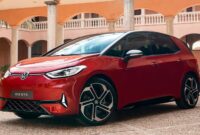Volkswagen killed the Passat in the United States after the 2022MY but the midsize family car soldiered on in Europe with its more sophisticated MQB underpinnings. The Old Continent is getting a ninth generation of Wolfsburg’s best-selling nameplate ever, after the Golf but ahead of the Beetle. Since the vehicle’s inception in 1973, VW has delivered 30+ million units. The new B9 comes strictly as a wagon as the sedan is officially dead.
Featuring revised underpinnings (MQB Evo) shared with the upcoming next-gen Tiguan and Golf Mk8 facelift, the 2024 Passat Variant is considerably larger than the old Euro-spec B8. It now stretches at 193.5 inches (4917 millimeters) in length, therefore making it a substantial 5.7 in (144 mm) longer than before. Width is up by 0.8 in (20 mm) to 72.9 in (1852 mm) while height is largely unchanged, at 59.2 in (1506 mm). As for the wheelbase, it has been elongated by 1.97 in (50 mm) to 111.8 in (2841 mm).

34 Photos
While not revolutionary, the styling isn’t evolutionary either since there are quite a few changes as VW has aligned the new Passat with the design of its electric ID models. Recently spotted without any camouflage, the ID.7 Variant looks a tad more futuristic but the similarities are easy to notice. As usual, the exterior appearance will depend on the trim level: Passat, Business, Elegance, and R-Line. Wheels up to 19 inches in size are going to be offered, along with newly developed matrix LED headlights and dynamic LEDs at the rear where a light bar has been fitted.
The interior represents a complete departure from the Passat B8 since VW has eliminated most of the switchgear. You’ll be accessing nearly all of the available functions from the touchscreen, which will measure a generous 12.9 inches even in the base model. At an additional cost, the infotainment can be upsized to 15 inches. A fully digital 10.25-inch instrument cluster is standard, so the German brand is saying goodbye to the good ol’ analog dials that were offered on the outgoing Passat.
By moving the gear selector onto the steering column, the engineers were able to free up space between the seats for extra cargo capacity in the same vein as on the ID.7. Further mirroring the electric sedan is a new switch on the left side to control the turn signals and wipers. Comfort in the front can increase by opting for the new heated, ventilated, and massaging seats with 14-way electrical adjustment.


That jump in size we mentioned earlier has not only increased legroom but also the luggage compartment capacity by 1.41 cubic feet (40 liters) to 24.3 cu ft (690 l) with the rear seats up. Fold the bench and the volume jumps to 67.8 cu ft (1,920 l) or a whopping 4.9 cu ft (140 liters) more than on the previous Passat Variant.
The engine lineup is comprehensive and it includes a mild-hybrid gasoline unit for the first time in the Passat’s history. It’s a 1.5-liter eTSI cylinder deactivation technology and 148 horsepower (110 kilowatts). Up next is a bigger 2.0 TSI with 201 hp (150 kW) in front-wheel-drive flavor and a more potent configuration with 261 hp (195 kW) and 4Motion all-wheel drive.
If you’ll still want a diesel in 2024, VW has got you covered with its 2.0 TDI offered in three states of tune: 121 hp (90 kW) and 148 hp (110 kW) as FWD models and 190 hp (142 kW) with AWD. All gasoline and diesel versions of the new Passat route power to the road via a seven-speed, dual-clutch automatic transmission.


Then there are the plug-in hybrids marketed as “eHybrid” models. The base variant offers 201 hp (150 kW) and 258 pound-feet (350 Newton-meters) of torque whereas the more potent model pushes out 268 hp (200 kW) and 295 lb-ft (400 Nm), making it the strongest Passat money can buy. These two PHEVs get a 1.5-liter TSI, a six-speed DSG, and a 19.7-kWh battery pack providing up to 62 miles (100 kilometers) of electric range.
With the new-generation Passat, VW has implemented support for DC fast-charging at 50 kW to juice up the battery from 10 to 80 percent in approximately 25 minutes. With the battery charged and a full tank of gas (11.9 gallons or 45 liters), you’ll be able to drive for around 621 miles (1,000 kilometers) before having to refuel.
Making its public debut next week at IAA Munich, the 2024 VW Passat is scheduled to go on sale in the first quarter of next year. It won’t be built in Germany anymore as production is moving to Bratislava, Slovakia where it’s going to be assembled alongside the new Skoda Superb. Unlike the wagon-only Passat, its Czech sibling will retain both liftback and wagon body styles.



